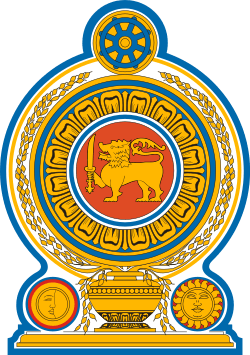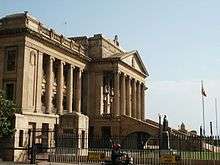President of Sri Lanka
| Present President of Sri Lanka
ශ්රී ලංකා ජනාධිපති இலங்கை சனாதிபதி | |
|---|---|
|
| |
| Style |
The Honourable (Informal) His Excellency (Formal and diplomatic) |
| Member of | Cabinet |
| Residence | President's House |
| Appointer | Direct election votes |
| Term length | Five years, renewable once |
| Constituting instrument | Constitution of the Democratic Socialist Republic of Sri Lanka |
| Inaugural holder | William Gopallawa |
| Formation | 22 May 1972 |
| Website |
President Presidential Secretariat |
 |
| This article is part of a series on the politics and government of Sri Lanka |
|
|
Political parties |
|
|
|
|
Foreign policy |
|
Related issues
|
The President of the Democratic Socialist Republic of Sri Lanka (Sinhalese: ශ්රී ලංකා ජනාධිපති Sri Lanka Janadhipathi; Tamil: இலங்கை சனாதிபதி) is the elected head of state and head of government of Sri Lanka. The President leads the executive branch of the Sri Lankan government and is the commander-in-chief of the Sri Lankan Armed Forces.
The office was created in 1972 and the president remains the single most dominant political office in the country. The current President is Maithripala Sirisena.
History
At independence, executive power in Ceylon resided with the monarch, represented by the Governor-General, which was exercised on the advice of the Prime Minister. The 1972 constitution removed the monarch and replaced the governor-general with a president, but it remained a mostly ceremonial position.
The 1978 constitution moved from a Westminster-based political system into one modeled on France. As in France, a new, directly elected President with a longer term and independence from Parliament was created. The President is the commander-in-chief of the armed forces, head of the Cabinet, appoints the prime minister, and could dissolve parliament (after one year has passed since the convening of parliament after a parliamentary election) The 17th constitutional amendment of 2001 reduced certain powers of the President in particular in regard to the appointment of the upper judiciary and independent commissions such as the election commission or the bribery and corruption commission.
In practice, the Sri Lankan presidency was much more powerful than the President of France. French presidents traditionally deal only with defense and foreign policy, leaving domestic affairs to the Prime Minister. Sri Lankan presidents are involved with every aspect of the government and are able to hold cabinet portfolios, or can bypass the cabinet posts by delegating decisions to the Presidential Secretariat.
The Nineteenth Amendment to the Sri Lankan Constitution implemented restrictions on the powers of the presidency. It limited the presidency to two, five year terms. The amendment mandates that the president consult the prime minister on ministerial appointments. It curtails any president’s immunity by making him liable to fundamental rights litigation on any official act.[1]
Powers
Presidents have little constraints on their power and they cannot be taken to court. However they can be impeached by a two-thirds majority in Parliament. They can place the country in a state of emergency, under which they can override any law passed and promulgate any regulation without needing legislative approval. However, to prolong the state of emergency for more than a month parliamentary approval is needed.
At the opening of Parliament, the President delivers an address similar to a Speech from the Throne, outlining government policy.
The President has the power to appoint Attorneys-at-Laws to the position of President's Counsel and military personnel to the post of Aide de Camp to the President.
After the recent Sri Lankan presidential election, 2015 current President of Sri Lanka Maithripala Sirisena has pledged in a 100-day work program to bringing in constitutional reforms to return to Westminster-style government based on an executive cabinet responsible to parliament.[2]
Residence

The official residence of the president is the President's House (formerly the Queen's House as the residences of the Governor-General) in Colombo. However the president's office is the Presidential Secretariat which is at the former Parliament building in Colombo, where many formal functions takes place. Other presidential residences include:
- the President's Pavilion, in Kandy, is a presidential residences used for (rare) state functions;
- the Queen's Cottage is the official presidential vacationing residence in the town of Nuwara Eliya.
In recent years from time to time Prime Minister's House, commonly referred to as Temple Trees, which has been the official residence of the Prime Minister since 1948, has been used by presidents. In 2015 President Sirisena refuse to use Presidents House or the Temple Trees and use his former ministerial residence at Wijayarama Mawatha. The Temple Trees was given back to Prime Minister Ranil Wickremesinghe which he uses for official work only and resides at his private house in Colombo 7.
Security
President's Security Division (PSD) is the main unit of the charged with the close protection of the President of Sri Lanka. During Former President Mahinda Rajapakse's era The specialized Army unit 'President's Guard' was formed for Presidential Security. Prior to the formation of the President's Guard, army personnel served as a squadron under the President's Security Division since 1996 and focused on key tasks including the perimeter security of Presidential residence, Temple Trees. 5th Regiment Sri Lanka Armoured Corps was the first army unit chosen to be in the dedicated security of the President of Sri Lanka during the presidency of Chandrika Bandaranaike Kumaratunga.However, in April 2015, President Maithripala Sirisena dissolved the President's Guard.[3] Currently President's security division is under Special Task Force (STF) of Sri Lanka Police
List of Presidents
Last election
.jpg)
| Candidate | Party | Votes | % | |
|---|---|---|---|---|
| Maithripala Sirisena | New Democratic Front | 6,217,162 | 51.28% | |
| Mahinda Rajapaksa | United People's Freedom Alliance | 5,768,090 | 47.58% | |
| Ratnayake Arachchige Sirisena | Patriotic National Front | 18,174 | 0.15% | |
| Namal Ajith Rajapaksa | Our National Front | 15,726 | 0.13% | |
| Maulawi Ibrahim Mohanmed Mishlar | United Peace Front | 14,379 | 0.12% | |
| A. S. P. Liyanage | Sri Lanka Labour Party | 14,351 | 0.12% | |
| Ruwanthileke Peduru | United Lanka People's Party | 12,436 | 0.10% | |
| Aithurus M. Illias | Independent | 10,618 | 0.09% | |
| Duminda Nagamuwa | Frontline Socialist Party | 9,941 | 0.08% | |
| Siritunga Jayasuriya | United Socialist Party | 8,840 | 0.07% | |
| Sarath Manamendra | New Sinhala Heritage | 6,875 | 0.06% | |
| Pani Wijesiriwardene | Socialist Equality Party | 4,277 | 0.04% | |
| Anurudha Polgampola | Independent | 4,260 | 0.04% | |
| Sundaram Mahendran | Nava Sama Samaja Party | 4,047 | 0.03% | |
| Muthu Bandara Theminimulla | All Are Citizens, All Are Kings Organisation | 3,846 | 0.03% | |
| Battaramulle Seelarathana | Jana Setha Peramuna | 3,750 | 0.03% | |
| Prasanna Priyankara | Democratic National Movement | 2,793 | 0.02% | |
| Jayantha Kulathunga | United Lanka Great Council | 2,061 | 0.02% | |
| Wimal Geeganage | Sri Lanka National Front | 1,826 | 0.02% | |
| Valid votes | 12,123,452 | 100.00% | ||
| Rejected votes | 140,925 | |||
| Total polled | 12,264,377 | |||
| Registered electors | 15,044,490 | |||
| Turnout | 81.52% | |||
See also
- List of Presidents of Sri Lanka
- Prime Minister of Sri Lanka
- Presidential Secretariat
- President's Security Division
- President's Guard
- Official state car of President of Sri Lanka
- Air transports of Heads of Government of Sri Lanka
References
- ↑ "Strides in the right direction". The Economist. Apr 30, 2015. ISSN 0013-0613. Retrieved 2015-05-11.
- ↑ "PRESIDENT MAITHRIPALA SIRISENA'S 100 DAY WORK PROGRAMME". 10 January 2015. Daily News Sri Lanka. Retrieved 10 January 2015.
- ↑ Army personnel removed from Presidential Guard
- ↑ "Presidential Election 08-01-2015 – Official Results – All Island Final Result". Department of Elections, Sri Lanka.
External links
- The official website of the President of the Democratic Socialist Republic of Sri Lanka
- The official website of the Presidential Secretariat of the Democratic Socialist Republic of Sri Lanka
- The official website of the Parliament of Sri Lanka - list of Heads of State
.svg.png)
.jpg)